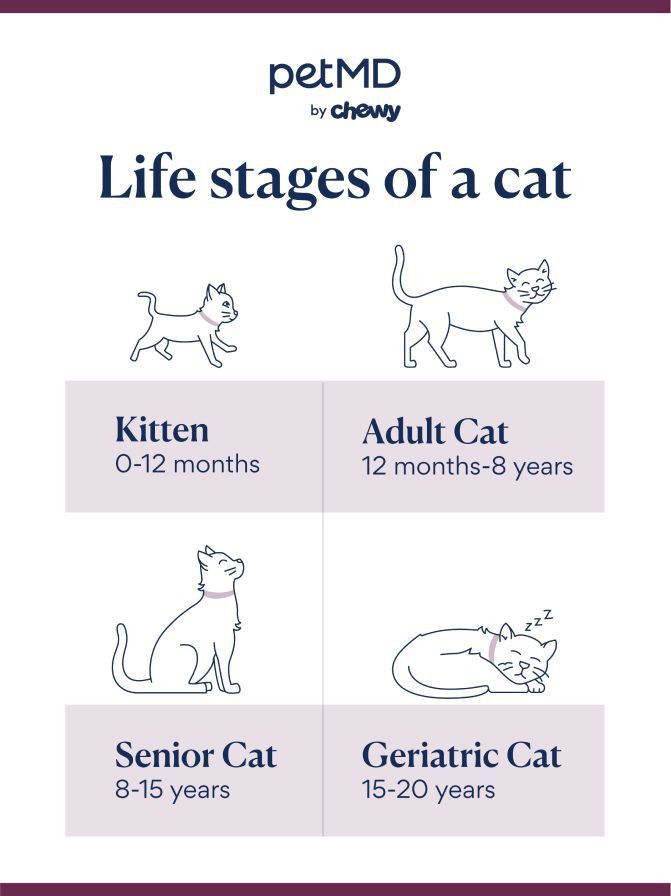Thanks to remarkable advancements in veterinary medicine, enhanced nutrition, and dedicated pet care, our beloved feline companions are enjoying longer and healthier lives than ever before. As responsible pet parents, it’s our privilege and duty to guide our kitties through each stage of their lives, ensuring they receive the appropriate care to thrive well into their golden years.
If you’ve ever pondered, “How Old Can Cats Live?” or sought to decipher your cat’s age in human years, the answer is multifaceted. It hinges significantly on the collaborative partnership between you and your veterinarian, focusing on crucial aspects such as your cat’s dietary needs, vaccination protocols, oral hygiene practices, and environmental enrichment throughout their journey.
This comprehensive guide delves into the fascinating world of cat lifespans, exploring the average life expectancy of cats and providing actionable insights into how you can actively contribute to extending your feline friend’s healthy and happy life.
Key Insights to Enhance Your Cat’s Longevity
- A cat’s diet, consistent preventive healthcare, and whether they are spayed or neutered are pivotal factors influencing their lifespan.
- Building a strong relationship with your veterinarian is essential to proactively address your cat’s health needs and ensure a long and fulfilling life.
- Observing and promptly addressing any changes in your aging cat’s behavior through consultations with your vet is crucial for their well-being.
Decoding the Average Lifespan of a Cat
Generally, the average cat lifespan ranges from 13 to 17 years. However, remarkable felines have been documented to live for 20 years or even longer. Creme Puff, a truly exceptional cat, holds the Guinness World Record for the oldest cat ever recorded, reaching an astounding 38 years of age. This remarkable example underscores the potential for feline longevity.
Numerous elements interplay to determine a cat’s lifespan. These key factors include:
- Nutrition: A well-balanced and complete diet is the cornerstone of a cat’s health. It provides essential nutrients, vitamins, and minerals that are vital for optimal organ function, a robust immune system, and maintaining a healthy body weight. High-quality cat food formulated for their specific life stage is crucial for longevity.
- Lifestyle: A cat’s lifestyle has a direct and significant impact on their lifespan. Indoor cats generally outlive their outdoor counterparts primarily because they are shielded from environmental hazards and consistently receive routine preventive veterinary care, thanks to their attentive owners.
- Preventive Care: Proactive preventive care is paramount. Cats that receive complete vaccinations and undergo routine blood work benefit from early detection and treatment of potential health issues. Regular preventive medications for parasites like fleas, ticks, and heartworms are also crucial, preventing debilitating diseases transmitted by these pests and contributing to a longer, healthier life.
- Breed: Breed predisposition plays a role in feline longevity. Certain breeds, such as Siamese cats, tend to live longer than others, like Maine Coons. Siamese cats are often associated with fewer breed-specific health problems, whereas Maine Coons, being larger, may be predisposed to certain health conditions related to their size.
- Mixed-breed cats frequently exhibit greater longevity compared to purebred cats due to a phenomenon known as hybrid vigor. The genetic diversity in mixed breeds often results in enhanced health and resilience to genetic predispositions.
- While tabby is a fur pattern and not a breed, tabby cats often enjoy impressive lifespans, frequently reaching 15–20 years.
- Genetics: A cat’s genetic makeup and inherited predispositions to certain diseases can influence their lifespan. Reputable breeders prioritize genetic testing to minimize the transmission of hereditary conditions.
- Spaying/Neutering: Spaying or neutering your cat is a significant factor in extending their life expectancy. Sterilized cats have a considerably lower risk of developing reproduction-related cancers and uterine infections in females, and testicular cancer and prostate issues in males. This is attributed to the elimination of hormonal imbalances associated with reproductive cycles.
 Content of cat life stages and average lifespan of cats
Content of cat life stages and average lifespan of cats
Indoor Cats vs. Outdoor Cats: Contrasting Life Expectancies
Sadly, outdoor cats, or those with frequent outdoor access, typically have a significantly shorter lifespan, averaging only about half that of indoor cats. Outdoor environments present numerous hazards that drastically reduce a cat’s life expectancy. These dangers include:
- Infectious Diseases: Exposure to contagious diseases from wildlife or other cats, such as feline leukemia virus (FeLV), feline immunodeficiency virus (FIV), and rabies.
- Trauma: Injuries resulting from encounters with predators (coyotes, dogs, or other aggressive animals) or vehicular accidents are significant threats.
- Parasites: Higher risk of parasitic infestations, including fleas, ticks, mites, and intestinal parasites, which can lead to various health complications.
While some cats may benefit from supervised outdoor activities like leash walking or exploring secure outdoor enclosures for mental and physical enrichment, the majority of cats thrive as indoor-only pets in a thoughtfully enriched indoor environment.
Indoor cats benefit from extended lifespans due to protection from these external dangers, consistent access to quality nutrition, and regular veterinary care, contributing to a higher average cat age compared to their outdoor counterparts.
Navigating Cat Life Stages for Optimal Care
As your cat gracefully ages, they progress through distinct life stages, each characterized by unique behavioral and health requirements. Understanding these stages allows for tailored care to ensure their well-being at every age.
Kitten (Birth to 1 Year): The Foundation of a Long Life
A kitten’s primary purpose is rapid growth and learning to navigate their world. This playful and formative stage is crucial for establishing a foundation for a healthy and well-adjusted adult cat.
While kittens often naturally learn essential habits like using the litter box and feeding, socialization and engaging in appropriate play are vital. Interactive play, puzzle toys, and scratching posts contribute to their mental and physical development, preventing behavioral issues later in life.
Providing a kitten-specific diet is critical during this phase, as their nutritional needs are higher to support rapid growth and development. Kitten food formulas are calorie-dense and contain balanced nutrients to fuel their growth spurts. Look for an Association of American Feed Control Officials (AAFCO) nutritional adequacy statement on the food label, confirming it’s “complete and balanced nutrition for growing kittens.”
Kittenhood is also the critical period for initiating core vaccinations, protecting them from preventable infectious diseases. These include FVRCP (feline viral rhinotracheitis, calicivirus, and panleukopenia), rabies, and FeLV vaccines. Spaying or neutering is typically recommended around 6 months of age to prevent unwanted pregnancies and reduce the risk of certain cancers and undesirable behaviors like urine marking.
Young Adult (1–6 Years): Maintaining Peak Condition
Young adult cats remain energetic and playful but have completed their physical growth. At this stage, their caloric needs decrease, and transitioning to adult cat food is essential to prevent weight gain. Maintaining a healthy weight is crucial in this phase as it minimizes the risk of developing conditions like arthritis and diabetes later in life.
Continuing routine vaccinations and annual veterinary check-ups remains important, even though young adult cats are generally resilient. However, certain conditions like asthma and feline lower urinary tract disease (FLUTD) are more frequently diagnosed during these years. Early detection through regular vet visits and baseline blood work can facilitate timely intervention and management, contributing to long-term health.
Mature Adult (6–10 Years): Adapting to Subtle Changes
Mature adult cats may exhibit a gradual slowdown in activity levels and transition to a more sedentary lifestyle. Subtle behavioral shifts may become noticeable, including changes in litter box habits or nocturnal activity patterns. Some cats may become more active at night and sleep more during the day, while others may become less meticulous about covering their waste in the litter box or start urinating outside the designated area.
Providing accessible resources becomes increasingly important. Consider switching to an uncovered litter box with low sides to accommodate senior cats with potential mobility issues, making it easier for them to enter and exit.
These changes can sometimes indicate underlying health concerns, such as arthritis, cognitive dysfunction (feline dementia), or early signs of kidney or digestive issues. Annual blood work is crucial for mature cats to monitor kidney, liver, and thyroid function, enabling early detection and management of potential problems.
Closely monitoring grooming habits, incidence of hairballs, and weight fluctuations is also important. Attention to oral health is paramount, and dental cleanings should be considered, especially for cats that resist tooth brushing. Establishing a consistent home dental care routine, if possible, using cat-specific toothbrushes and toothpaste, can significantly contribute to their long-term oral health and reduce the need for frequent professional cleanings.
Senior (10+ Years): Prioritizing Comfort and Care
The transition to the senior cat stage is variable. Some cats in this age range remain remarkably active and mobile, while others experience more age-related health challenges.
Semi-annual veterinary check-ups, including blood work and urine testing, are generally recommended for cats 10 years and older. Organ function can change rapidly in senior cats, and these tests help detect and address issues promptly. Senior cats are also more susceptible to high blood pressure (hypertension), which can lead to serious complications like strokes and blindness. Blood pressure monitoring should be a routine part of senior cat check-ups.
Senior cats often exhibit a more pronounced slowdown compared to mature adults, which can be a sign of untreated arthritis pain. If not already implemented, consult your veterinarian about joint supplements to support joint health and mobility. Providing comfortable orthopedic beds can offer essential cushioning and support for aging joints, enhancing their comfort and quality of life.
Extending Your Cat’s Lifespan: Actionable Steps
While there’s no magic formula to guarantee immortality, several proactive measures can significantly contribute to increasing your cat’s lifespan and ensuring a healthier, happier life.
- Maintain Up-to-Date Vaccinations: Vaccinations tailored to your cat’s lifestyle are crucial for preventing potentially fatal diseases. Even indoor cats require vaccinations as they can still be exposed to diseases.
- Spay or Neuter Early: Spaying or neutering at a young age dramatically reduces the risk of life-threatening reproductive diseases and cancers, contributing significantly to a longer lifespan.
- Commit to Preventative Care: Cats are masters at concealing illness. Annual veterinary check-ups and routine blood tests are vital for early disease detection. A strong veterinarian-client-patient relationship allows your vet to recognize subtle changes during examinations. Discuss any behavioral changes with your vet, no matter how minor they may seem.
- Adapt Your Cat’s Environment to Age-Related Needs: As cats age, modifying their environment enhances their comfort and accessibility. Discuss joint supplements with your vet if you observe signs of slowing down or stiffness. Provide orthopedic beds for enhanced joint support and consider ramps or steps to help them access favorite spots comfortably.
By understanding the factors that influence feline lifespan and implementing these proactive care strategies, you can play a vital role in helping your cat live a longer, healthier, and more fulfilling life by your side.
WRITTEN BY
Jamie Lovejoy, DVM
Veterinarian
Dr. Jamie Lovejoy graduated from Tufts Cummings School of Veterinary Medicine in 2012 after completing her undergraduate degree in Marine Biology. …

